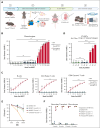In utero hematopoietic stem cell transplantation for Fanconi anemia
- PMID: 38991119
- PMCID: PMC11399615
- DOI: 10.1182/bloodadvances.2023011894
In utero hematopoietic stem cell transplantation for Fanconi anemia
Conflict of interest statement
Figures


References
-
- Soulier J. Fanconi anemia. Hematology. 2011;2011(1):492–497. - PubMed
-
- Kitao H, Takata M. Fanconi anemia: a disorder defective in the DNA damage response. Int J Hematol. 2011;93(4):417–424. - PubMed
-
- Kutler DI, Singh B, Satagopan J, et al. A 20-year perspective on the International Fanconi Anemia Registry (IFAR) Blood. 2003;101(4):1249–1256. - PubMed
-
- Yabe M, Morio T, Tabuchi K, et al. Long-term outcome in patients with Fanconi anemia who received hematopoietic stem cell transplantation: a retrospective nationwide analysis. Int J Hematol. 2021;113(1):134–144. - PubMed
Publication types
MeSH terms
LinkOut - more resources
Full Text Sources

